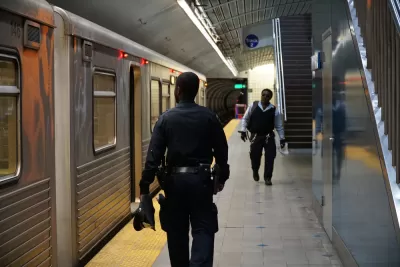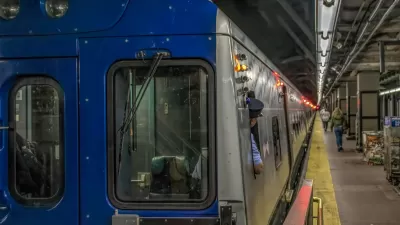Some transit agencies are launching ‘ambassador’ programs that use unarmed personnel to respond to safety concerns and reduce interactions with armed law enforcement.

Advocates have long called for a decrease in armed police presence on public transit, citing research showing that a police presence doesn’t necessarily contribute to a safer environment and discourages ridership. Now, transit agencies are starting to shift their approach when it comes to transit security, writes Henry Pan in Next City.
“Last year, BART Police began to pilot its Transit Ambassadors program, using uniformed but unarmed personnel to respond to riders facing homelessness, mental health emergencies, drug overdoses and other crises.” For now, these ambassadors are still accompanied by police officers, but BART’s Chief Communications Officer Alicia Trost says “The idea is to really reimagine safety and to meet the needs of all types of riders, but especially marginalized communities who are often not listened to, or or often aren’t given resources based on their needs.”
According to Pan, “Deploying ambassadors seems to be working. During the pilot period between February and August of 2020, ambassadors called police to resolve less than 1% of the over 14,000 interactions they have with riders. Reports on sexual harassment, sexual assault and lewd behavior sent by riders through their BART Watch app are also decreasing, from 2% in 2019 to less than 1% so far this year.”
Similarly, “The Massachusetts Bay Transportation Authority has an ambassador program that relies on contractors, with the Los Angeles County Metropolitan Transportation Authority to follow next month. Metro Transit’s Police Department in the Twin Cities created a Homeless Action Team in 2018 that connected over 400 formerly unhoused people who ride the system for shelter to public housing managed by its parent agency, the Metropolitan Council.”
For now, BART plans to stick with police officers alongside the new ambassadors, citing the potential need for an armed response in the event of a major incident.
FULL STORY: Transit Agencies Try Decarceral Approaches to Improve Rider Safety

Alabama: Trump Terminates Settlements for Black Communities Harmed By Raw Sewage
Trump deemed the landmark civil rights agreement “illegal DEI and environmental justice policy.”

Planetizen Federal Action Tracker
A weekly monitor of how Trump’s orders and actions are impacting planners and planning in America.

Why Should We Subsidize Public Transportation?
Many public transit agencies face financial stress due to rising costs, declining fare revenue, and declining subsidies. Transit advocates must provide a strong business case for increasing public transit funding.

Understanding Road Diets
An explainer from Momentum highlights the advantages of reducing vehicle lanes in favor of more bike, transit, and pedestrian infrastructure.

New California Law Regulates Warehouse Pollution
A new law tightens building and emissions regulations for large distribution warehouses to mitigate air pollution and traffic in surrounding communities.

Phoenix Announces Opening Date for Light Rail Extension
The South Central extension will connect South Phoenix to downtown and other major hubs starting on June 7.
Urban Design for Planners 1: Software Tools
This six-course series explores essential urban design concepts using open source software and equips planners with the tools they need to participate fully in the urban design process.
Planning for Universal Design
Learn the tools for implementing Universal Design in planning regulations.
Caltrans
Smith Gee Studio
Institute for Housing and Urban Development Studies (IHS)
City of Grandview
Harvard GSD Executive Education
Toledo-Lucas County Plan Commissions
Salt Lake City
NYU Wagner Graduate School of Public Service





























